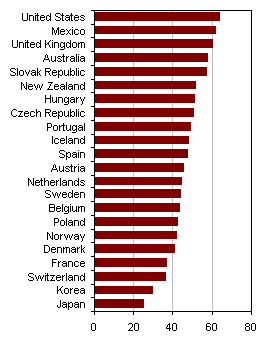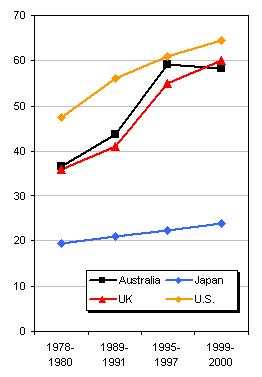|
Changes in lifestyles, as well as higher consumption rates of foods rich in fat and carbohydrates, are contributing considerably to a more overweight population around the world. This article considers socioeconomic causes and consequences of obesity. Obesity is an international problem, and as such is compared on an international basis where data are available.
Overview
Obesity is a growing health concern for both developed and developing countries. World Health Organization (WHO) figures indicate that obesity is a "global epidemic." Obesity is a severe condition of overweight. There are more than one billion overweight adults, and at least 300 million of them are clinically obese. Overweight affects more people than malnutrition and hunger (WHO, 2004). However, economists still know very little about its causes, consequences, and potential remedies. In particular, economists wonder why obesity is more prevalent in Western industrialized countries, many developing countries, and new transitional economies.
Unfortunately, obesity is not a well-documented problem; thus, statistical data are hard to obtain. Figure 1 shows percentages of overweight and obese individuals for Organisation for Economic Co-operation and Development (OECD) countries (OECD, 2004). The United States has the highest percentage of obese and overweight population (64.5%); Mexico (62.3%), the United Kingdom (61%), and Australia (58.4%) follow close behind. The lowest percentages are recorded in Japan (25.8%) and Korea (30.6%).
Globally, the incidence of weight-related problems is the highest ever reported (Figure 2). As in the United States, overweight rates remained more-or-less stable in OECD countries during the 1980s and grew enormously in the 1990s. Many speculate that this trend may go up, particularly when we consider the incidence of obesity among children and adolescents. According to the American Obesity Association (2004), the percentage of obese children grew from 7% in 1976-1980 to 15.3% in 1999-2000. A similar trend occurred among adolescents, rising from 5% in 1976-1980 to 15.5% in 1999-2000. Multiple studies have shown that obese children are likely to become obese adults.
Consequences of Weight-Related Problems
Obesity and overweight problems have serious social and economic consequences. Multiple studies have shown that obesity negatively affects earnings and wages, particularly for females (Cawley, 2004). In the OECD, obesity-related medical costs are rising, although the contribution of obesity to the total health bill is not easy to determine. Obesity carries both direct and indirect costs. Direct costs include those for preventive, diagnostic, and treatment services. Indirect costs occur through losses in labor-force participation due to increases in health-related problems, including type 2 diabetes, heart disease, certain cancers, stroke, and depression. Table 1 shows statistical correlation rates between the percentage of obese and overweight individuals and data on health costs and other socio-demographic variables in OECD countries. The data show that increased incidence of obesity is associated with increased observed health expenditures and decreased life expectancy.
Studies based in the United States reveal that health-care costs for overweight and obese individuals averages 37% more than for people of normal weight, adding an average of $732 to the annual medical bills of each American. Estimated medical costs connected to obesity and smoking each account for about 9.1% of all health expenditures in the United States (Finkelstein, Fiebelkorn, & Wang, 2003).
Exploring the Roots of the Problem
Leaving genetics aside, weight-related problems are caused by the difference between calories consumed and calories used. Cultural and sociodemographic factors contribute to this calorie imbalance. Some argue that obesity growth is mainly due to a higher intake of calories, but others state that it is mainly caused by a lower expenditure of calories in daily activities.
In connection with the higher-calorie-intake argument, a popular justification is the growth of fast-food and soft-drink consumption, associated with increases in dietary intake of saturated fats, sugars, and calories. In addition, increases in serving portions are also considered quite important. Other researchers argue that female labor participation is a contributing factor: Presumably, healthier home-cooked dinners have been widely replaced by TV dinners or restaurant dinners—which frequently take place in fast-food restaurants. Cutler, Glaeser, and Shapiro (2003) analyze changes in food consumption between the mid-1970s and mid-1990s and observe that the growth in calories is enough to explain the increase in weight. In the process, they partially invalidate the fast-food argument, pointing out that the main reason for increased dietary caloric intake was calories consumed outside the main meals (i.e., snacks). They also failed to find a strong interrelationship between obesity and the number of women working.
In terms of calories expended, other researchers emphasize the role of reduced physical activity and technological change—products of the transition from rural to urban societies—as well as a higher rate of passive entertainment. Lakdawalla and Philipson (2002) concluded that a worker who spends his/her career in a sedentary job will be heavier than someone in a highly active job. Further, they estimated that about 40% of the total growth in weight in the United States may be due to expansion in calories, potentially through increased food abundance (agricultural innovation), and about 60% due to demand factors, such as a decrease in physical activity.
Other potential economic explanations which justify the imbalance of calories refer to the consequences of becoming a more industrialized society in which the value of time increases. As Chou, Grossman, and Saffer (2004) point out, in industrialized societies, workers sell more of their time to the labor market and have less disposable time for entertainment and other household activities (including food preparation). This lack of time is what may explain the growth of fast-food restaurants in the United States. Their results indicate that not only restaurant availability and restaurant food prices matter when explaining weight gain, but also a set of sociodemographic characteristics of the individuals. In particular, they conclude that wealthier and more educated individuals are less likely to have obesity problems, whereas black and Hispanic are more likely to suffer from obesity or have higher weights. Thus, all evidence shows that obesity is a complex phenomenon, linked not only to the demand and supply conditions of food products, but also to economic transitions and cultural change of societies. This makes it harder to disentangle.
What Do the Data Tell Us?
It is difficult to develop a globally applicable explanation of weight-related problems, because different socioeconomic and cultural factors are at work (Loureiro & Nayga, 2004). The proliferation and impact of weight-related problems vary largely between most European countries, North America, and the Asian countries. One of the main reasons is higher calorie intake, which may contribute to calorie imbalance (Table 2). According to the OECD, US daily calorie intake grew by 716 calories (almost 25%) between 1973 and 1999. Significant calorie growth was observed elsewhere in the Netherlands, New Zealand, and Spain. On the contrary, in Japan, for example, there is a clear control of calorie intake, and calorie growth during the last 20 years has been the lowest in the entire OECD. This corresponds with one of the lowest rates of weight problems in the OECD. However, in countries such as Australia, the daily calorie intake during the same period has grown also moderately (87 calories), while the percentage of obese individuals increased by 23.4%. Thus, it seems that the spread of obesity has not been caused everywhere by higher calorie intake, although calorie intake has gone up in all OECD countries over the past decade. In the context of the OECD, female labor participation may have contributed to unhealthy food habits. Table 1 shows that countries with more females working outside the house are more likely to suffer weight-related problems. Other factors, such as the transition from rural to urban societies, changes in food habits, and the reduction of strenuousness of work, also contribute.
An interesting finding is that countries with a higher percentage of urban population are more likely to suffer weight-related problems (Table 1). As shown in Table 2, Australia, Netherlands, and the U.K, all with almost 90% of the total population living in urban areas, have large percentages of overweight population. By contrast, in countries where the percentage of individuals living in urban areas is smaller, weight-related problems are also present and serious, as in the United States. This may be due to the mechanization and technical progress of agriculture, which could be reducing significantly the daily use of calories in rural areas while increasing the calorie supply. In general, a preliminary data analysis confirms that in OECD countries, obesity is linked to many of the same factors as in the United States, related to the industrialization and westernization of societies around the world.
There are, however, some cultural differences that should be taken into consideration in order to understand the spread of obesity and weight-related problems around the world. For instance, the spirit of massive consumption and the idea of "getting a good value for your money" are more linked to some countries than others. In addition, the effects related to the imitation of western lifestyles are also different, depending on the degree of reception and adoption of these new cultural habits, which include the consumption of fast food, sodas, and snacks.
Conclusions
Population and consumption data reveal that socioeconomic and cultural factors are affecting the spread of obesity around the world. Although economists have recently started exploring the economic causes and consequences of obesity, providing a solution to this problem may require a complex vision that incorporates more than economic incentives to help consumers eat healthier foods (such as providing mandatory nutritional food information, taxing food products with high levels of sugars, carbohydrates, and fats, or subsidizing certain fruits and vegetables for lower-income groups). Given that both consumption and expenditure of calories matter, new health policies promoting more active lifestyles should be put forward by countries affected by the obesity epidemic. This would alleviate the symptoms of new sedentary lifestyles common to all industrialized countries. The fight against weight problems may also require having an understanding of the sociological perspectives of cultural change and economic growth, reminding individuals that "they are what they eat."
For More Information
American Obesity Association. (2004). Childhood obesity. Available on the World Wide Web: http://www.obesity.org/subs/childhood/prevalence.shtml.
Cawley, J. (2004). The impact of obesity on wages. Journal of Human Resources, 39(2), 451-474.
Chou, S.-Y., Grossman, M., & Saffer, H. (2004). An economic analysis of adult obesity: Results from the behavioral risk factor surveillance system. Journal of Health Economics, 23, 565-587.
Cutler, D.M., Glaeser, E.L., & Shapiro, Jesse M. (2003). Why have Americans become more obese? Journal of Economic Perspectives, 17(3), 93-118.
Finkelstein, E.A., Fiebelkorn, I.C., & Wang, G. (2003). National medical spending attributable to overweight and obesity: How much, and who's paying? Health Affairs, W3, 219-226. Available on the World Wide Web: http://content.healthaffairs.org/cgi/content/full/hlthaff.w3.219v1/DC1.
Lakdawalla, D., & Philipson, T. (2002). The growth of obesity and technological change: A theoretical and empirical examination (working paper 8946). Cambridge, MA: National Bureau of Economic Research.
Loureiro, M.L., & Nayga, Jr., R.M. (2004). Analyzing factors affecting obesity rates in OECD countries. Available on the World Wide Web: http://agecon.lib.umn.edu.
World Health Organization. (2004). Obesity and overweight. Geneva: WHO. Available on the World Wide Web: http://www.who.int/dietphysicalactivity/publications/facts/obesity/en/.
|
|
Other articles in this theme:
|
|
Table 1
Correlation coefficients between health variables, selected sociodemographics, and the presence of individuals suffering weight-related problems.
| Life expectancy |
-0.2577 |
| Potential years of life lost |
0.2568 |
| Health expenditures (% GDP) |
0.1676 |
| % rural population |
-0.3948 |
| % females in labor market |
0.3409 |
| Calorie consumption (per capita) |
0.5957 |
| GDP (per capita) |
-0.2385 |
|
|


